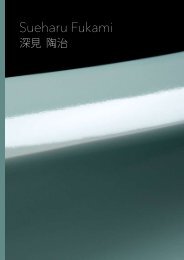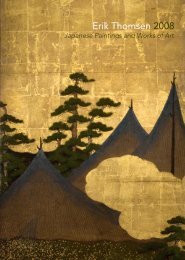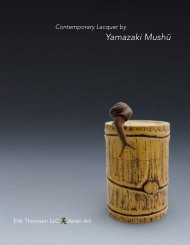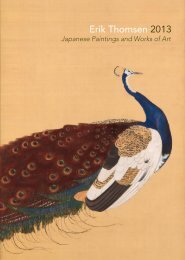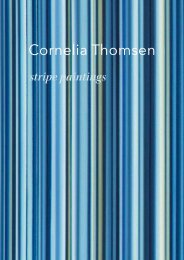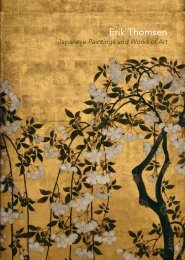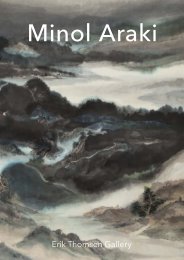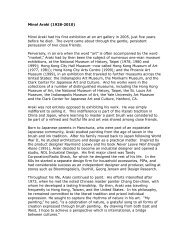View publication (pdf file 6.5 mb) - Erik Thomsen
View publication (pdf file 6.5 mb) - Erik Thomsen
View publication (pdf file 6.5 mb) - Erik Thomsen
- No tags were found...
You also want an ePaper? Increase the reach of your titles
YUMPU automatically turns print PDFs into web optimized ePapers that Google loves.
volumes 1– 3 (a total of 10 books) and republishedin 1836 with volumes 4 – 7 (a total of 20 books). Thetemple, located in Yotsuya, was founded in 1575.9 He is listed in a nu<strong>mb</strong>er of contemporary biographicaldictionaries featuring cultural figures ofthe time, for example: Ansei bungajin meiroku安 政 文 雅 人 名 録 from 1860.Nr. 14 Waterfall1 See, for example, an example of a hanging scrollover 3.6 meters in length in Sasaki Jōhei, SasakiMasako, Osaka Shiritsu Bijutsukan 大 阪 市 立 美 術 館 ,佐 々 木 丞 平 , 佐 々 木 正 子 , eds. Maruyama Ōkyo:Shaseiga sōzō e no chōsen tokubetsuten 円 山 応 挙 :写 生 画 創 造 への 挑 戦 特 別 展 . Tokyo: Mainichi Shinbunsha每 日 新 聞 社 , 2003, p. 1592 The details do not stop at the painted surface.Looking closely, one can see that the silk strips(ichimonji) above and below the painting has adécor of waves and clouds and function as anextension of the painted scene.3 For biographical details, see Yui Kazuto 油 井 一 人 .Nijusseiki bukko nihongaka jiten 20 世 紀 物 故 日 本画 家 事 典 . Tokyo: Bijutsu Nenkansha 美 術 年 鑑 社 ,1998, pp. 382 – 3.Nr. 15 The Snow of Kamogawa River1 The name of the Matsubara Bridge is also writtenon the inscription at the end of the box. The addressis given there as »Miyagawa 7-chō«, a shortening ofthe name Miyagawasuji. The present address is thesixth ward and not the seventh, perhaps a mistakeby the artist. The bridge is unchanged to this day andthere are still places for nocturnal entertainmenton the other side of the river.2 The album is noted in Nittenshi Hensan Iinkai日 展 史 編 纂 委 員 会 . Bunten, Teiten, Shin Bunten,Nitten zen shuppin mokuroku: Meiji 40-nen--Shōwa32-nen: Nitten shi shiryō 文 展 ・ 帝 展 ・ 新 文 展 ・ 日 展全 出 品 目 錄 : 明 治 40 年 -- 昭 和 32 年 : 日 展 史 資 料 .Tokyo: Nittenshi Hensan Iinkai 日 展 史 編 纂 委 員 会 ,1990, vol. 2, p. 28. See also: Paul Berry and MichiyoMorioka, Literati Modern: Bunjinga from Late Edoto Twentieth-Century Japan: The Terry Welch Collectionat the Honolulu Academy of Arts. Honolulu:Honolulu Academy of Arts, 2008, p. 265.3 This pair of screens, Kyoto in the Winter, is depictedand described in our 2009 <strong>publication</strong>, item 5.4 For a two-panel screen with a Chinese scenefrom the mid 1910’s, see the present <strong>publication</strong>,item <strong>6.5</strong> The use of gofun on the reverse side of a paintingis a technique used much earlier in Buddhist paintings.The painter Itō Jakuchū (1716 –1800) also usedthe technique in some of his finest paintings.6 For another work with a similar theme, see thepair of six-panel screens in the 2009 <strong>publication</strong>,item 5, featuring a winter scene of the Higashiyamadistrict. Here, too, was a remarkable display oftechnical abilities, especially in the virtuosic use ofgofun to depict falling snow.7 Baisen’s later works were criticized by some ofhis contemporary critics, who characterized himas an artist who peaks early and then levels off tomediocrity. In retrospect this seems highly undeserved,as the works of the mature artist are just asimaginative as the earlier, though not in an openlydemonstrative manner. A reappraisal of the artist’scareer and his role of twentieth century Nihongamovement are clearly needed. For one thing, hisremarkable success at national exhibitions is hardto deny: his work was accepted into every Teitenexhibition from the first to the very last and into allbut one Bunten exhibitions, twice with two entries.For short but useful biographies with paintings ofthis artist, see Ōtsu City Museum of History 大 津 市歴 史 博 物 館 , ed. Shirarezaru Nihon kaiga 知 られざる 日 本 絵 画 (English title: Unexplored Avenues ofJapanese Painting). Seattle and Ōtsu: University ofWashington Press, Ōtsu City Museum of History大 津 市 歴 史 博 物 館 , 2001, 36, 124, 190; Paul Berryand Michiyo Morioka, Modern Masters of Kyoto:The Transformation of Japanese Painting Traditions,Nihonga from the Griffith and Patricia Way Collection.Seattle: Seattle Art Museum, 1999, 270 – 3; andRoberts (1976), 43.8 See examples of the former in McKelway, Matthew,Capitalscapes: Folding Screens and Political Imaginationin Late Medieval Kyoto. Honolulu: HawaiiUniversity Press, 2006.Nr. 16 New Year with Small Pines and a Pair ofCranes1 See for example, the famous pair of cranepaintings by Wen Cheng (ac. 15th century) in theDaitokuji Temple and the later adaptations by ItōJakuchū (1716 –1800) in Money L Hickman andYasuhiro Satō. The Paintings of Jakuchū. New York:Asia Society Galleries, 1989, pp. 36 – 7.2 In addition, the tradition of displaying young pineseedlings—the so-called kadomatsu—at house entrancesat New Year became a Japanese tradition.3 See details of his life in the following <strong>publication</strong>s:Yui Kazuto 油 井 一 人 . Nijusseiki bukko nihongakajiten 20 世 紀 物 故 日 本 画 家 事 典 . Tokyo: Bijutsu Nenkansha美 術 年 鑑 社 , 1998, pp. 430 –1; Ellen P. Conant,et al., Nihonga, Transcending the Past: JapaneseStyle Painting, 1868 –1968. Saint Louis: The SaintLouis Art Museum and The Japan Foundation,1995, p. 329; and Ōtsu City Museum of History大 津 市 歴 史 博 物 館 , ed. Shirarezaru Nihon kaiga知 られざる 日 本 絵 画 (English title: UnexploredAvenues of Japanese Painting). Seattle and Ōtsu:University of Washington Press, Ōtsu City Museumof History 大 津 市 歴 史 博 物 館 , 2001, pp. 160 –1.Nr. 17 Set of Three Lacquer Paintings with Carps1 A nu<strong>mb</strong>er of paintings of carps were painted byMaruyama Ōkyo, who also specialized in waterfallpaintings. He famously created an image of thecli<strong>mb</strong>ing koi partly obscured by the streams of fallingwater. Mitsuzane clearly refers to these paintingand then recreates them in the medium of lacquer.For images of both types of carps by Ōkyo, seefor example Sasaki Jōhei, Sasaki Masako, OsakaShiritsu Bijutsukan 大 阪 市 立 美 術 館 , 佐 々 木 丞 平 , 佐々 木 正 子 , eds. Maruyama Ōkyo: Shaseiga sōzō e nochōsen tokubetsuten 円 山 応 挙 : 写 生 画 創 造 への 挑戦 特 別 展 . Tokyo: Mainichi Shinbunsha 每 日 新 聞 社 ,2003, p. 27.2 Another work by this talented artist, a standinglacquer screen with an image of a carp, can beseen in our 2007 <strong>publication</strong>, item 30.3 Nittenshi Hensan Iinkai 日 展 史 編 纂 委 員 会 . Bunten,Teiten, Shin Bunten, Nitten zen shuppin mokuroku:Meiji 40-nen--Shōwa 32-nen: Nitten shi shiryō 文 展 ・帝 展 ・ 新 文 展 ・ 日 展 全 出 品 目 錄 : 明 治 40 年 -- 昭 和 32 年 :日 展 史 資 料 . Tokyo: Nittenshi Hensan Iinkai 日 展 史 編纂 委 員 会 , 1990, vol. 2, p. 108.4 See: Sannomaru Shōzōkan 三 の 丸 尚 蔵 館 , ed. Iwaino bi: Taishōki kōshitsu gokeiji no shinajina 祝 美 大 正期 皇 室 御 慶 事 の 品 々. Tokyo: Kunaichō 宮 内 庁 , 2007Nr. 18 A Cat in a Melon Patch1 The process was originally developed by Rimpaschool artists, such as Ogata Kōrin, but was adoptedby the Nihonga school in the early twentiethcentury. Kōsui takes the process to new levels, forexample, even his signature on the top right of thepainting is created in ink mixed with gold.116 117



